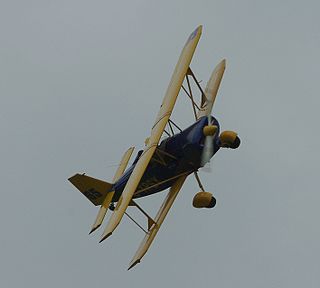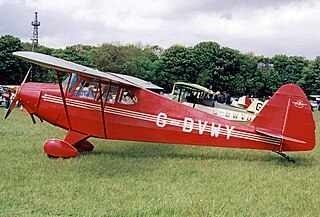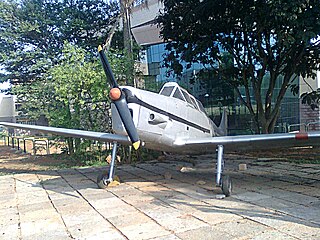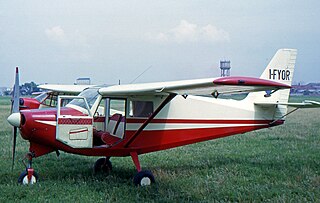
The Cessna Model 411 is an American twin-engined, propeller-driven, pressurized light aircraft built by Cessna Aircraft. It was that company's largest business aircraft to enter production when it first flew in 1962.

The Andreasson BA-4B is a single-seat aerobatic biplane which was marketed for homebuilding and also produced complete.

The Chasle YC-12 Tourbillon ("Whirlwind") was a single-seat light sporting aircraft developed in France in the mid-1960s and marketed for homebuilding via plans. It was a low-wing cantilever monoplane of conventional configuration. As designed, it featured fixed tailwheel undercarriage, but it could also be fitted with fixed tricycle gear.

The Hindustan Aeronautics HA-31 Basant is a 1970s Indian agricultural monoplane built by Hindustan Aeronautics.

The Porterfield Collegiate is an American-built two-seat training and touring monoplane built by the Porterfield Aircraft Corporation of Kansas City.

The HAL HT-2 is an Indian two-seat primary trainer designed and built by Hindustan Aeronautics Limited (HAL). The HT-2 was the first company design to enter production in 1953 for the Indian Air Force and Navy, where it replaced the de Havilland Tiger Moth. The HT-2 is a low-wing cantilever monoplane with a fixed tailwheel landing gear. Powered by a 155 hp (116 kW) Cirrus Major III piston engine, the aircraft has enclosed tandem cockpits with dual controls. Apart from military use, the aircraft was also used by Indian flying schools.

The PZL-102 Kos (blackbird) is a Polish two-seat touring and training monoplane designed and built by PZL.

The HAL HAOP-27 Krishak ('Farmer') was a military observation aircraft produced in India in the 1960s. It was initially developed by Hindustan Aeronautics as an enlarged, four-seat version of the HAL Pushpak light aircraft.
The Partenavia P.59 Jolly was an Italian two-seat training monoplane designed by Partenavia to meet a requirement for the Aero Club d'Italia. First fight was in 1960.
The Welch OW-5M were a family of American two-seat light cabin monoplanes designed by Orin Welch based on his first cabin monoplane design, the ACA Falcon. Welch's goal was to design cheap and functional light aircraft. The aircraft is a strut-braced high-wing monoplane with an enclosed cabin with side-by-side seats for two. It is similar in appearance to the Aeronca C-3, save for the wing struts. It had a steerable tailwheel landing gear and a nose-mounted engine. The fuselage was constructed with fabric covered welded steel tubing with a triangular cross section. The controls were mounted overhead with an adjustable control wheel that could be positioned for either pilot. Welch developed their own low-pressure wheels and tires for suspension.

The Macchi MB.320 was an Italian cabin monoplane designed and built by Macchi. Only a small number were built.

The Partenavia P.57 Fachiro is an Italian, four-seat, high-wing, touring monoplane, fitted with a fixed tricycle undercarriage.

The Wassmer WA-80 Piranha is a French two-seat low-wing cabin monoplane trainer designed and built by Société Wassmer. Based on the same construction as the company's WA-50 four-seater, the WA-80 was a scaled down version. The prototype, registered F-WVKR, first flew in November 1975 powered by a 100 hp Rolls-Royce Continental O-200 engine. Wassmer appointed a receiver and suspended production in 1977 after 25 had been built.

The Zlin 22 Junak was a 1940s two-seat cabin monoplane, developed from the Zlin 381.

The Scintex ML 250 Rubis was a French civil utility aircraft of the 1960s.

The Johnson Rocket 185 was a 1940s American two seat cabin monoplane designed by Johnson and built at Fort Worth, Texas.

The Scheibe SF-23 Sperling (en:Sparrow) is a 1950s German two-seat cabin monoplane.

The Aeronca C-1 Cadet was a high performance version of the Aeronca C-2 developed by Aeronca and first flown in 1931.
The Aeronca 12AC Chum was a 2-seat cabin monoplane designed and produced by Aeronca in the United States in 1946. The design was a licence-built version of the ERCO Ercoupe.
The IABSA Premier 64-01 was a Brazilian two-seat training and touring braced high-wing monoplane designed and built in small numbers by Industria Aeronáutica Brasileira (IABSA), powered by a 75 hp (56 kW) piston engine.

















